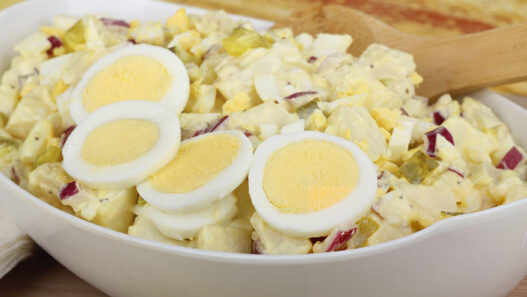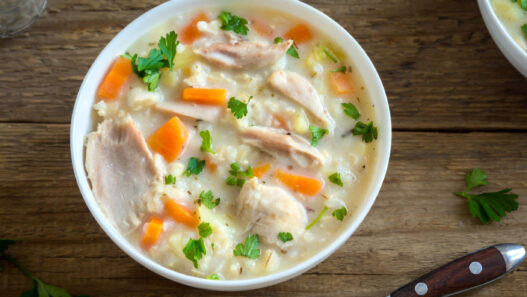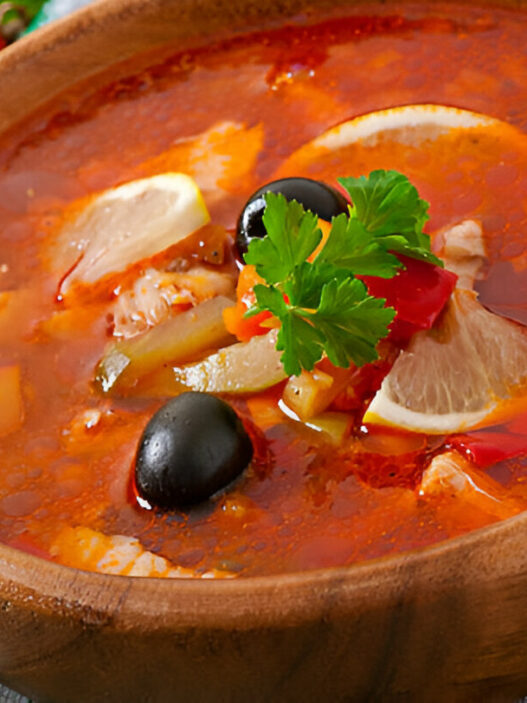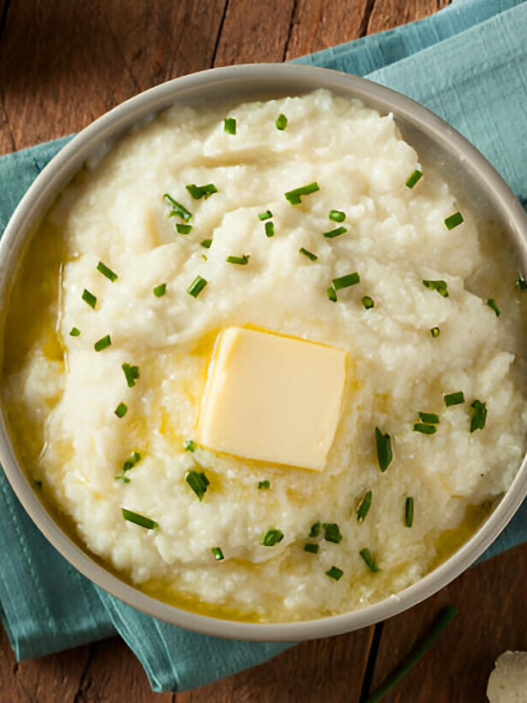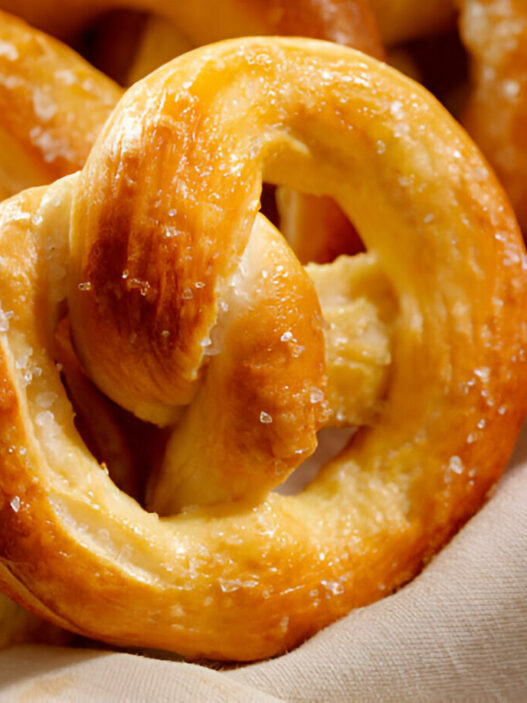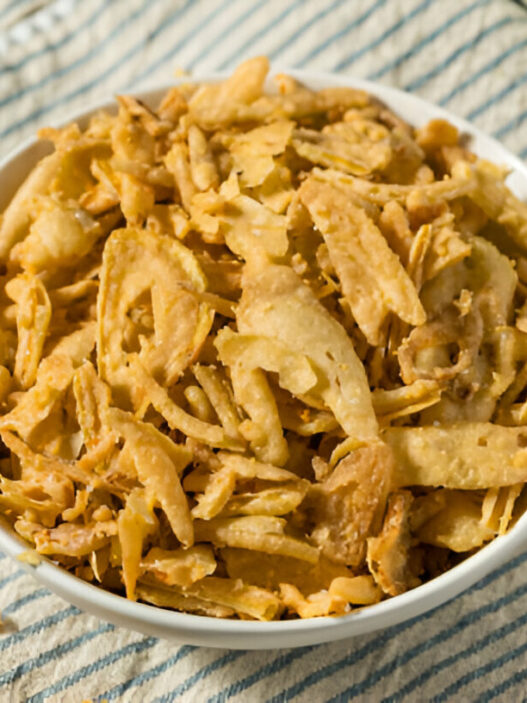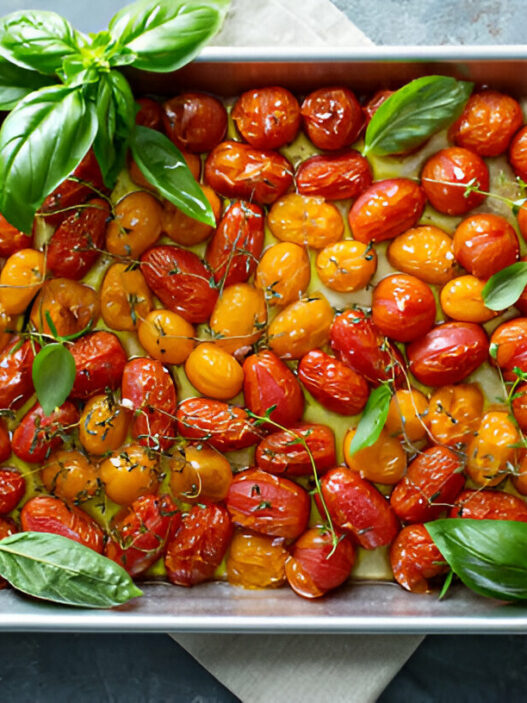A well-seasoned, herb-infused vegan stuffing is the perfect accompaniment to any holiday table or cozy family meal. This recipe delivers a satisfying contrast of textures, with a crisp, golden top and a tender, savory interior. Made with fresh herbs, sautéed aromatics, and warm spices, this stuffing is a versatile side dish that pairs effortlessly with a variety of mains. Whether served as classic scoopable stuffing or shaped into bite-sized stuffing balls, this dish brings comfort and rich flavors to every bite.
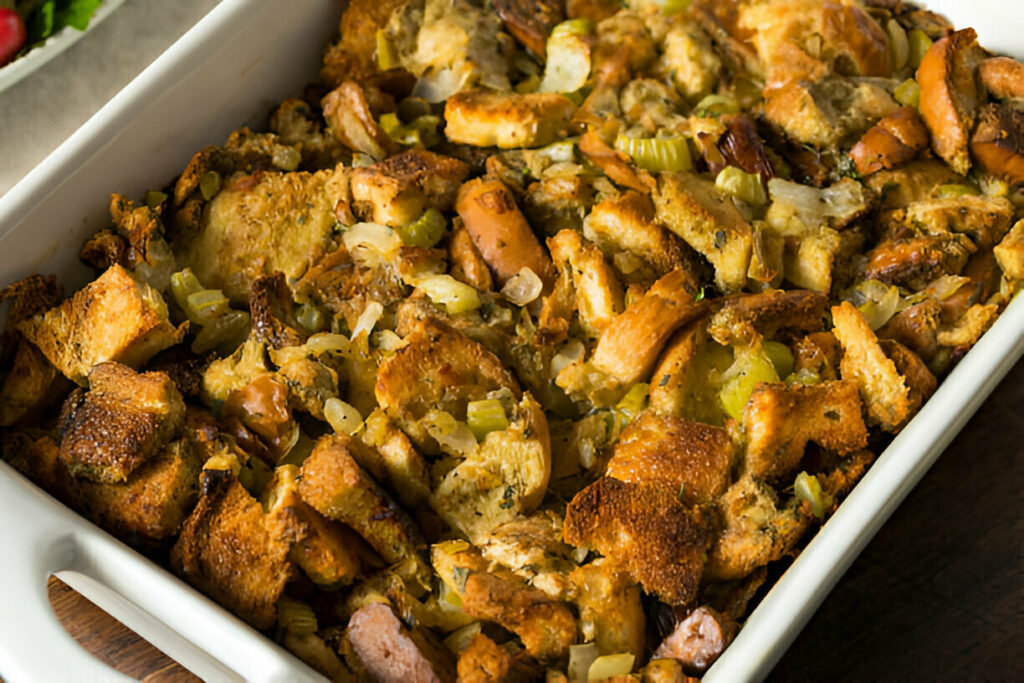
Ingredients Overview
Every ingredient in this stuffing plays a crucial role in building layers of flavor and texture. Bread serves as the base, absorbing the rich vegetable stock and aromatic seasonings. Stale bread is preferred, as it soaks up liquid more effectively without becoming mushy. The trio of onions, celery, and garlic adds a savory depth, while fresh sage, parsley, and rosemary create an earthy, herbaceous aroma that defines a classic stuffing.
Vegan butter enhances the richness, helping the flavors meld beautifully, while cornstarch acts as a subtle binder, ensuring the stuffing holds its shape. A high-quality vegetable stock ties everything together, infusing the bread with moisture and flavor. If needed, substitutions can be made—gluten-free bread works well for those with dietary restrictions, and dried herbs can be used in place of fresh ones if necessary.
Step-by-Step Preparation
Perfect stuffing starts with properly prepared bread. If using fresh bread, it must be dried out to achieve the best texture. Spreading cubed bread on a baking tray and baking it at a low temperature ensures it crisps up without browning, making it ideal for absorbing liquid while retaining some structure. The choice of bread also matters—rustic country bread, sourdough, or a hearty whole-grain loaf will add extra character and complexity to the stuffing.
Once the bread is ready, the next step is sautéing the aromatics. Cooking onions and fresh sage slowly in vegan butter allows them to release their natural sweetness while developing a deep, rich flavor. Stirring frequently prevents burning and encourages even caramelization. Once softened and golden, celery, minced garlic, parsley, and rosemary are added to the pan. These ingredients should be cooked just long enough for the celery to soften slightly and the herbs to release their fragrant oils.
To assemble the stuffing, the toasted bread cubes are tossed with cornstarch, which helps bind the mixture together. The sautéed vegetables and herbs are then folded in, ensuring the flavors are evenly distributed. Seasoning with flaky sea salt and black pepper at this stage allows the flavors to develop further.
At this point, two baking options are available. If making stuffing balls, hot vegetable stock is poured over the mixture, and it is left to soak for a few minutes. This helps soften the bread just enough to allow shaping. The mixture is then rolled into 10–12 equal-sized balls and arranged on a lined baking sheet before being baked to a golden crisp. Alternatively, for a traditional scoopable stuffing, the prepared mixture is spread evenly in an ovenproof dish, the hot vegetable stock is poured over the top, and it is baked until slightly crisp on the surface but still moist underneath.
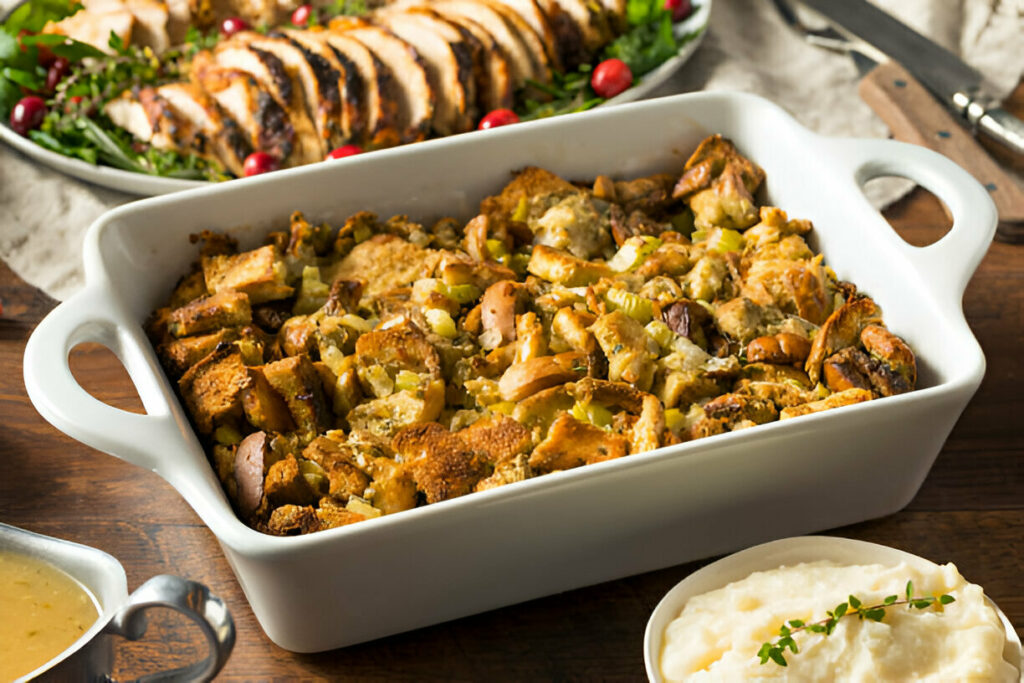
Recipe Tips & Frequently Asked Questions
How to get a crispy top layer while keeping the inside moist:
Use a shallow baking dish to increase surface area, allowing more of the stuffing to crisp up.
Adjusting the moisture level based on the type of bread used:
Dense bread varieties require more stock, while lighter breads need less to avoid becoming too soggy.
Enhancing the flavor with additional seasonings or mix-ins:
Toasted nuts, dried cranberries, or caramelized mushrooms can add extra depth and texture.
Can I make this stuffing ahead of time? Yes, assemble the mixture and refrigerate it for up to 24 hours before baking. Add a splash of stock before reheating to keep it moist.
What is the best bread to use for stuffing?
A hearty, rustic loaf like sourdough, ciabatta, or multigrain bread provides the best texture and flavor absorption.
Can I make this stuffing gluten-free?
Yes, simply substitute gluten-free bread and ensure the vegetable stock is certified gluten-free.
What to Serve With This Recipe
Vegan stuffing pairs beautifully with a variety of main courses and side dishes. It complements traditional holiday dishes like roasted vegetables, mashed potatoes, and a rich plant-based gravy. For a comforting meal, serve it alongside lentil loaf, stuffed squash, or a hearty mushroom Wellington.
Beyond holiday meals, this stuffing can be used creatively in everyday cooking. Serve leftovers with a warm autumn soup, toss into a grain bowl for added texture, or repurpose it into a breakfast hash with sautéed greens and crispy potatoes.
Storage and Reheating Tips
To maintain the best texture, store leftover stuffing in an airtight container in the refrigerator for up to four days. When reheating, avoid microwaving, as it can make the stuffing rubbery. Instead, place it in the oven at 170°C, covered with foil to retain moisture, and bake for 10–15 minutes until warmed through. If the stuffing seems dry, drizzle a bit of vegetable stock over it before reheating.
For longer storage, stuffing can be frozen for up to one month. Defrost overnight in the refrigerator before reheating in the oven to restore its crispy exterior and soft interior.
This vegan stuffing delivers all the warmth and savory goodness of a traditional recipe while staying entirely plant-based. Its combination of crispy edges, soft center, and bold herbaceous flavor makes it an essential addition to any feast. With customizable ingredients, various serving options, and easy make-ahead preparation, this stuffing is a timeless dish that can be enjoyed beyond the holiday season.

Ingredients
285 g bread, cut into small cubes (preferably stale)
110 g vegan butter
1 onion, finely chopped
2 stalks celery, finely diced
2 cloves garlic, peeled and minced
2 tablespoon fresh sage, finely chopped
2 tablespoon fresh parsley, finely chopped
2 tablespoon fresh rosemary, finely chopped
2 tablespoon cornstarch (also known as cornflour)
350 ml vegetable stock, boiling hot
Pinch of flaky sea salt and ground black pepper
Instructions
If using fresh bread instead of stale, preheat the oven to 130°C. Spread the bread cubes in a single layer on a baking tray and place in the oven for 20 minutes to dry out. Once crisp, remove from the oven and allow them to cool completely. Adjust the oven temperature to 170°C.
In a large frying pan over medium-low heat, melt the vegan butter. Once fully melted, add the chopped onion and sage. Cook gently for about 15 minutes, stirring regularly, until the onions turn golden and fragrant.
Stir in the celery, minced garlic, parsley, and rosemary. Continue cooking for a few more minutes, allowing the celery to soften and the herbs to release their aroma. Remove from heat and set aside.
In a large mixing bowl, toss the bread cubes with the cornstarch until evenly coated. Add the sautéed onion and herb mixture, stirring well to combine. Season with salt and black pepper to taste.
For stuffing balls, pour the hot vegetable stock over the mixture, stirring until everything is well moistened. Cover the bowl with a clean tea towel and let the mixture absorb the liquid for 5 minutes. Using your hands, shape the mixture into 10–12 evenly sized balls and arrange them on a lined baking tray. Bake for 20 minutes at 170°C until golden and crisp on the outside.
For traditional scoopable stuffing, transfer the prepared mixture into an ovenproof dish. Evenly pour the hot vegetable stock over the mixture, ensuring it is fully absorbed. Bake in the preheated oven for 20 minutes, until the top is lightly browned and slightly crisp.
Remove from the oven and serve immediately as a flavorful, herb-infused side dish.

Vegan Stuffing Recipe
Ingredients
- 285 g bread cut into small cubes (preferably stale)
- 110 g vegan butter
- 1 onion finely chopped
- 2 stalks celery finely diced
- 2 cloves garlic peeled and minced
- 2 tablespoon fresh sage finely chopped
- 2 tablespoon fresh parsley finely chopped
- 2 tablespoon fresh rosemary finely chopped
- 2 tablespoon cornstarch also known as cornflour
- 350 ml vegetable stock boiling hot
- Pinch of flaky sea salt and ground black pepper
Instructions
- If using fresh bread instead of stale, preheat the oven to 130°C. Spread the bread cubes in a single layer on a baking tray and place in the oven for 20 minutes to dry out. Once crisp, remove from the oven and allow them to cool completely. Adjust the oven temperature to 170°C.
- In a large frying pan over medium-low heat, melt the vegan butter. Once fully melted, add the chopped onion and sage. Cook gently for about 15 minutes, stirring regularly, until the onions turn golden and fragrant.
- Stir in the celery, minced garlic, parsley, and rosemary. Continue cooking for a few more minutes, allowing the celery to soften and the herbs to release their aroma. Remove from heat and set aside.
- In a large mixing bowl, toss the bread cubes with the cornstarch until evenly coated. Add the sautéed onion and herb mixture, stirring well to combine. Season with salt and black pepper to taste.
- For stuffing balls, pour the hot vegetable stock over the mixture, stirring until everything is well moistened. Cover the bowl with a clean tea towel and let the mixture absorb the liquid for 5 minutes. Using your hands, shape the mixture into 10–12 evenly sized balls and arrange them on a lined baking tray. Bake for 20 minutes at 170°C until golden and crisp on the outside.
- For traditional scoopable stuffing, transfer the prepared mixture into an ovenproof dish. Evenly pour the hot vegetable stock over the mixture, ensuring it is fully absorbed. Bake in the preheated oven for 20 minutes, until the top is lightly browned and slightly crisp.
- Remove from the oven and serve immediately as a flavorful, herb-infused side dish.

